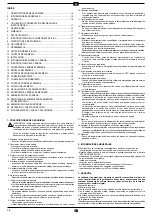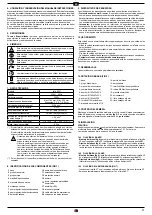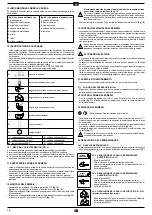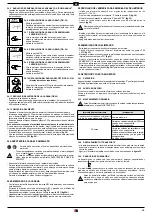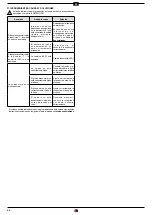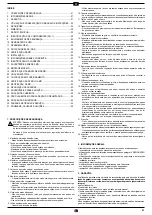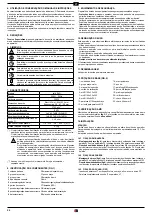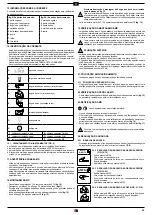
8
EN
15. CHAIN INFORMATION
The chain must be completely inspected before sharpening it to make sure it is intact.
(fig. 8) Cutter parts:
(fig. 8A) Chain parts:
1
Top part
1
Connection link
2
Top cutting angle
2
Left cutter
3
Side cutting angle
3
Right cutter
4
Sharpening recess
4
Driving link (pulling link)
5
Depth gauge
5
Rivet
6
Bit
7
Heel
8
Rivet hole
16. CHAIN IDENTIFICATION
- Before you start to sharpen, you need to know the type of chain and the relative
adjustment angles. These characteristics are written in the owner’s manual of the
chain saw on which the chain is fitted or on the chain pack.
- The chain identification code is usually written on the driving link.
- You can also identify the chain using a template or gauge.
- Consult the CHAIN CHART at the end of this manual.
The columns in this chart provide the following information:
A
÷ 2
Chain pitch
B
Driving link width
C
Top sharpening angle (vise rotation)
D
Cutting angle (arm rotation)
E
Down angle (vise inclination)
F
Gauge depth
G
Grinding wheel thickness
H
Grinding wheel code
I
Oregon chain codes
N
Carlton chain codes
L
Windsor chain codes
O
Stihl chain codes
M
SARP chain codes
P
EM chain codes
16.1 INSTRUMENTAL MEASUREMENTS (FIG.9)
a - Measure the gauge depth using the suitable shape.
b - Put the template on this side and measure the chain PITCH.
c - Put the template on this side to measure the cutter length.
d - The driving link width is measured using a suitable instrument (i.e. gauge).
17. GRINDING WHEEL WARNINGS
- Use a grinding wheel suitable for the type of chain to be sharpened; consult the
chain chart at the end of the manual.
- Do not force the grinding wheel on the hub and do not alter the centering hole
diameter. Do not use grinding wheels that do not fit perfectly in place.
- Use exclusively clean and perfect intact hub and flange to fit the grinding wheel.
- Make sure the outside diameters of the hub and flange are identical.
18. FITTING THE GRINDING WHEEL
- Unscrew the screws V10 and remove the guard P10
(fig.10)
.
- Remove the screw V8 and the flange F8 on the hub
(fig.11)
- Choose the grinding wheel based on the type of chain to be sharpened (column H
in chain chart).
- Insert and perfectly center the grinding wheel in the dedicated seat on the
hub
(fig.12)
.
- Insert the flange F8 and tighten the screw V8
(fig.13)
.
Make sure you fit the flange as illustrated in fig.12.
If the grinding wheel is fitted with the flanges too tight, it could break during
use and put the operator at risk. To avoid such risk, tighten screw M6x25
to
7 Nm
(if possible, check with dynamometric spanner).
- Reassemble the guard P10 and tighten the related screws V10
(fig.14)
.
19. CHECKING THE ASSEMBLY OF THE GRINDING WHEEL
- Stand at the side of the grinding wheel, start the grinder and visually make sure
the grinding wheel does not oscillate sideways or crosswise, consequently causing
abnormal vibrations.
- If this should be the case, stop the appliance immediately and check if the grinding
wheel has been fitted correctly. If necessary, replace the grinding wheel with another
original one.
Always check a freshly fitted grinding wheel at working speed for at least one
minute before you start grinding, standing at a safe distance and making sure
nobody else approaches the appliance.
20. ELECTRICAL CONNECTION
- Make sure the electrical system power supply complies with the values written on
the rating nameplate.
- The power supply voltage must not differ from that written on the nameplate
by ±5%.
- The connection to the electric mains must be prepared subject to current standards
in force in the country in which the appliance is used.
- The power socket used for the appliance must have an earth wire, adequate fuse
and must be protected by a differential circuit breaker with tripping sensitivity no
higher than 30 mA.
21. START-UP
- Plug the power cable into the mains.
21.1 OPERATOR POSITION (FIG.14A)
- The operator must stand in front of the machine and maintain a position that allows
him to grip the arm correctly and adjust the vice.
22. CHECKING THE GRINDING WHEEL SHAPE
- With the appliance turned off, check the grinding wheel profile using the dedicated
template
(fig.15)
; if necessary, dress the wheel to restore the correct profile.
23. GRINDING WHEEL DRESSING
Wear personal protection equipment.
- Start the grinder by turning the switch to position “1”.
- Once started, the lamp lights up to illuminate the sharpening area.
- Profile the grinding wheel with the dressing brick, always working with extreme
caution, holding it firmly and securely
(fig.16)
.
- Stop the appliance and check if the profile is correct using the template
(fig.17)
.
Contact with the grinding wheel while it spins at high speed may cause
burning and abrasions.
24. ADJUSTING THE GRINDER
24.1 SHARPENING ANGLES
- Once you have established the type of chain to be sharpened, look-up the adjust-
ment angles (vise and arm) in the chain chart (columns C/D/E).
RH
CUTTER
24.2 SETTING THE TOP SHARPENING ANGLE (FIG.18-19)
- Loosen the knob M20.
- Turn the vise clockwise.
- Position the reference mark on the vise by the desired angle.
- Tighten knob M20 again.
LH
CUTTER
24.3 SETTING THE TOP SHARPENING ANGLE (FIG.18-20)
- Loosen the knob M20.
- Turn the vise counter clockwise.
- Position the reference mark on the vise by the desired angle.
- Tighten knob M20 again.
24.4 SETTING THE CUTTING ANGLE (FIG.21-21A)
(right and left cutters)
- Loosen the knob M23 and turn the arm towards the right. Position
the reference mark by the angle desired.
- Tighten knob M23 again.
Summary of Contents for 930-8060
Page 2: ......
Page 118: ...116 Jolly EVO 230V Spare Parts 9 10 13 15 11 8 7 1 8 18 4 11 14 12 9 2 3 6 6 5 4 17 16 ...
Page 124: ...122 A29 P29 M32 A29 I33 P31 P30 26 29 28 27 ...
Page 125: ...123 80 75 M32 29A M32 29B 30 32 P30 P29 31 ...
Page 126: ...124 P31 34 35 33 ...
Page 127: ......


















